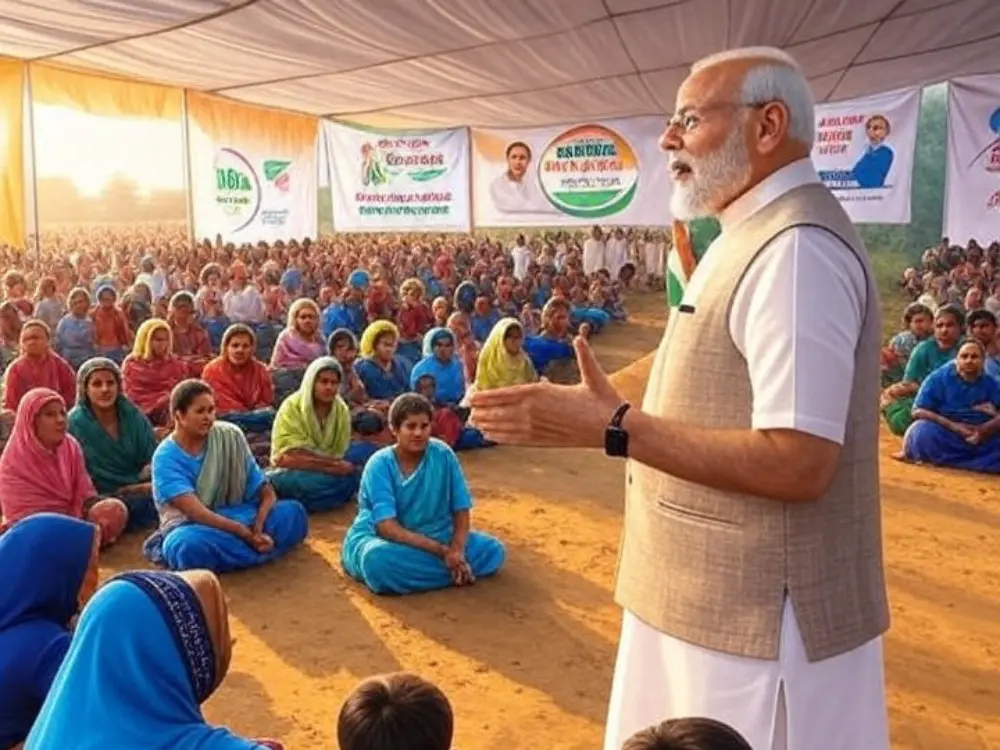Ayodhya’s Transformation Ram Mandir Fuels Economic Boom, The holy city of Ayodhya in India is undergoing a remarkable transformation, fueled by the construction of the grand Ram Mandir. This iconic temple is not just a spiritual symbol, but also a catalyst for economic prosperity. The Ram Mandir’s completion is expected to attract millions of pilgrims, potentially surpassing established pilgrimage centers like the Vatican City and Mecca. This surge will boost not only religious tourism, but also hospitality, transportation, and souvenir manufacturing. To cater to the influx, a $10 billion infrastructure makeover is underway. This includes a new international airport, a revamped railway station, improved road connectivity, and a new township with hotels and amenities. Rs 4 lakh crore revenue figure is a realistic estimate for the fiscal year 2024-25.
Table of Contents
ToggleHistorical Significance Of Ram Temple:
Ram Temple (Ram Janmabhoomi) is a significant religious and historical site in Ayodhya, India. The term “Janmabhoomi” translates to “birthplace,” and in this context, it refers to the birthplace of Lord Rama, a central figure in the epic Hindu poem Ramayana. The site has been at the center of a long and complex historical and religious dispute, culminating in the demolition of the Babri Masjid in 1992 and the ongoing construction of a Ram Mandir temple.
Ancient Origins: Ayodhya, believed to be the birthplace of Lord Rama has been a center of Hindu pilgrimage for centuries. It is mentioned in ancient texts like the Ramayana, one of the two major Sanskrit epics of ancient India. The Ramayana, believed to be composed between the 3rd and 5th centuries BCE, Archaeological evidence suggests settlements in the area dating back to the 6th century BCE.
The Ramayana, attributed to the sage Valmiki, narrates the life and adventures of Lord Rama. According to Hindu tradition, Rama is considered the seventh avatar of Lord Vishnu, and his birthplace is highly venerated.
Ayodhya Dispute Escalates: The Babri Masjid
Construction of the Babri Masjid: Ayodhya was a flourishing Hindu kingdom until the 12th century Muslim conquests. In the 16th century, during the Mughal era, a mosque known as the Babri Masjid was constructed in Ayodhya. The exact circumstances surrounding its construction are a subject of historical debate.
Dispute Begins: The dispute over the site started gaining prominence in the 19th century when tensions between Hindu and Muslim communities escalated. The mosque became a focal point of religious contention.
In 1992, a large crowd of Hindu activists, including political leaders, gathered at the Babri Masjid and demolished it, claiming that it was built on the birthplace of Lord Rama. The demolition led to widespread communal riots and tensions across India. The Ram Janmabhoomi movement, spearheaded by various Hindu organizations, gained momentum during this period.
Legal Proceedings:
Supreme Court verdict: The Indian Supreme Court ruled in favor of the Ram Janmabhoomi Nyas, a trust established for the construction of Ram Mandir temple in 2019. The Supreme Court also allocated five acres of land next to the disputed site, on which a mosque will be built.
Bhoomi Pujan and Temple Construction: The beginning of August 2020 saw a grand ceremony known as Bhoomi Pujan held to launch the construction work of the Ram temple. Furthermore, this facility is meant to be an embodiment of national unity and is expected to attract millions of people around India.
Progress update: Works are well under way at Ram Mandir as ground floor is almost complete. Now it’s time for erection including installation of idol Rama at sanctum sanctorum. With regard to religious interfaith harmony and understanding, Ram Janmabhoomi Teerth Kshetra Trust has embarked upon various outreach programmes.
Building a Dream: The Consortium Behind the Ram Mandir Construction
The construction of the Ram Mandir in Ayodhya is led by a consortium of top Indian companies, with Larsen & Toubro (L&T) in charge. L&T takes care of all construction works and, Tata Projects, AECOM India, Wienerberger India, and Janson Day are among many other companies that participate in various capacities. In addition, the company has assured that Shri Ram Janmabhoomi Mandir will last 1000 years, as it pointed out its strength and permanence.
“The Total Cost of Building the Ram Mandir in Ayodhya”
Many factors have been considered while determining the cost of building Ram Mandir in Ayodhya. The estimation which was put at Rs 1,800 crore ($225 million) by September 2022 when it was suggested by Shri Ram Janmabhoomi Teerth Kshetra Trust could go beyond this amount due to unforeseen obstacles and fluctuations in prices of raw materials. For now, this projection pertains only to the main temple but there may be other costs associated with adding more temples to the project, a place for pilgrims’ help center, a herb park and infrastructure facilities. For example compensating for lost businesses located around Ayodhya or improving its infrastructure would entail additional costs not necessarily indicated in official estimates; hence they can be regarded as hidden expenses. Meanwhile public donations have accounted for over Rs 3,200 crore ($400 million) as at October 2023 with tax-free bonds issued in 2021 raising Rs 1,000 crore ($125 million).
“Ram Mandir’s Economic Impact: SBI Research Predicts Massive Boost for Uttar Pradesh”
According to SBI Research, the Ayodhya Ram Mandir is expected to provide an economic boost for the month of January 2023. They are estimating that it can generate between 200 billion and 250 billion rupees annually in tax revenue for the Uttar Pradesh state government. The main reason for this increase was a rise in the number of tourists visiting and hence more commercial activities around that place. Taxes would be the majorities’ portion of this revenue collection going directly to the state government which will be good news to businesses that operate within these regions, their workers as well as residents who depend on those businesses.
“Ayodhya’s Ram Temple: Catalyst for Tourism Boom with Projected 50 Million Annual Visitors, Jefferies (global brokerage firm) Reports”
“The Ram temple in Ayodhya is set to revolutionize tourism in India, attracting more than 50 million visitors a year, according to a report by global US brokerage Jefferies. This expected spike in tourism is not seen as.” not only a spiritual journey but as an inspiration for.” significant growth in regional infrastructure. Ayodhya.” It could attract a staggering 50 million to 100 million visitors a year, surpassing popular destinations like Vatican City (9 million visitors) and Mecca (20 million visitors) .The flow is expected to affect the state in and of international travelers eager to experience the magnificent Ram temple .”
Also Read-Top 10 Best Tourist Places To Visit In Ayodhya
Some Frequently Asked Questions:
Who is leading the construction of the Ram Mandir in Ayodhya?
The construction of the Ram Mandir is led by a consortium of top Indian companies, with Larsen & Toubro (L&T) overseeing overall construction management. Other key contributors include Tata Projects, AECOM India, Wienerberger India, and Janson Day.
What is the assurance regarding the longevity of the Ram Mandir?
L&T, the construction company, has assured that the Shri Ram Janmabhoomi Mandir is built to last 1000 years, emphasizing its durability and longevity.
What is the estimated cost of building the Ram Mandir in Ayodhya?
Initially estimated at Rs. 1,800 crore (US$225 million) by the Shri Ram Janmabhoomi Teerth Kshetra Trust in September 2022, The project relies on public donations, with over Rs. 3,200 crore (US$400 million) reportedly received by October 2023. Tax-free bonds issued in 2021 also raised Rs. 1,000 crore (US$125 million).
What is the economic impact of the Ram Mandir, according to SBI Research?
SBI Research predicts a massive economic boost for Uttar Pradesh, estimating an additional 20,000-25,000 crore in tax revenue for the state government annually.
What does Jefferies’ report suggest about the tourism impact of the Ram Temple?
Jefferies, a global brokerage firm, projects that the Ram Temple in Ayodhya could draw in over 50 million visitors annually, surpassing popular pilgrimage destinations like Vatican City and Mecca. This surge is expected to not only serve as a spiritual pilgrimage but also act as a catalyst for significant growth in the region’s infrastructure.
How is the Ram Temple expected to impact tourism in India?
The Ram Temple is anticipated to transform tourism in India, with projections of more than 50 million visitors each year. This influx is expected to include both domestic and international pilgrims, contributing to the economic development of the region.













